The role of food in climate change has emerged as one of the defining challenges of our time. The journey of steak, fruit or salads from the vastness of agricultural lands to the plates on our table leaves a significant footprint on the environment.
At the heart of this challenge is the heavy use of fertilizers and the growing global population’s demand for meat.
As earth, climate and atmospheric scientists, we track global greenhouse gas emissions and have published the most comprehensive assessment yet of a powerful greenhouse gas from food production: nitrous oxide, or N₂O.
After carbon dioxide and methane, N₂O is the most consequential greenhouse gas released by humans into the atmosphere. Although there is less N₂O than carbon dioxide in the atmosphere, it is 300 times more powerful at warming the planet, and remains in the atmosphere, retaining heat, for over a century. Today, atmospheric N₂O levels are about 25% higher than before the Industrial Revolution, and are still rising at an accelerating rate.
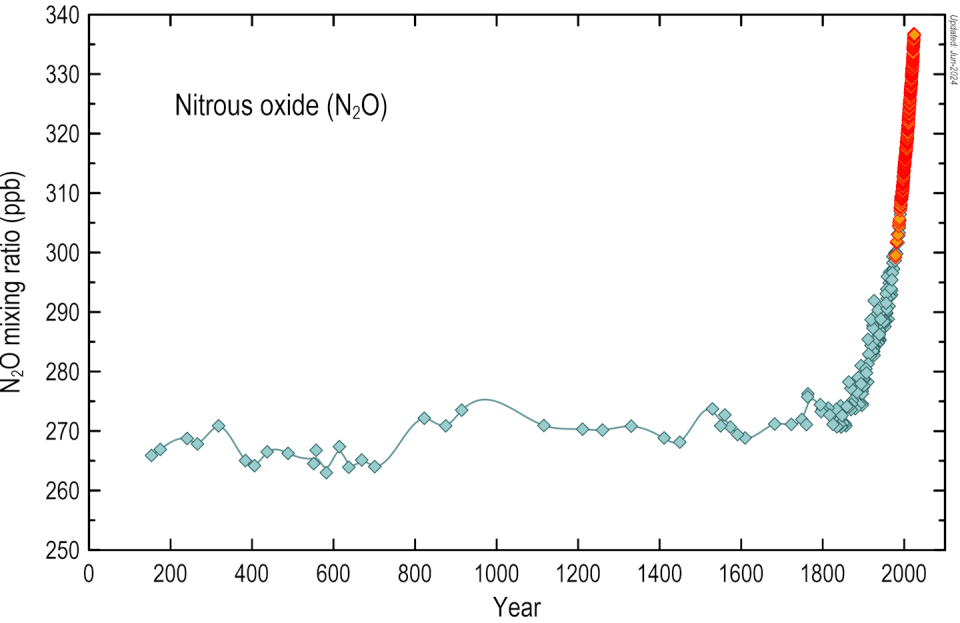
We found that globally, fertilizers and livestock manure management are leading the increase in N₂O emissions and their rapid accumulation in the atmosphere. This is more than a climate problem. N₂O also depletes the ozone layer, which protects people from harmful solar radiation. And nitrogen runoff from fields pollutes waterways, increasing harmful algal blooms and creating oxygen-depleted dead zones.
The growth of N₂O emissions is alarming, but people have the knowledge and many of the technologies needed to reverse the trend.
Where do N₂O emissions come from?
Before the Industrial Revolution, natural sources of N₂O from microbes living in forest soils and oceans were nearly equal to natural pools that consumed N₂O in the air, so the atmospheric concentration of N₂O was fairly constant.
However, the human population and its demand for food have increased rapidly, causing that natural balance to be reached.
We found that human activities alone have increased N₂O emissions by 40% over the past four decades, with agriculture contributing about 74% to total anthropogenic N₂O emissions.
The largest human sources of N₂O are agriculture, industry and the burning of forests or agricultural waste.
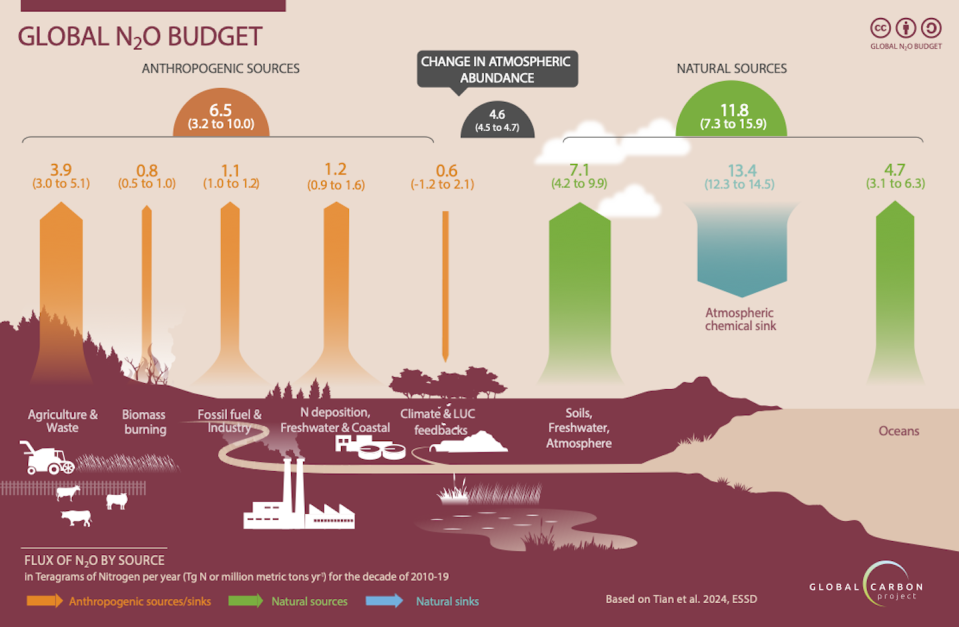

Nitrogen fertilizers, widely used in agriculture, are one of the biggest contributors. Fertilizers are responsible for 70% of total agricultural N₂O emissions worldwide. Animal manure from intensive animal farming contributes about 30%. A smaller source but one that is growing rapidly is aquaculture, such as fish farming, especially in China where it has increased twenty-five times in the last 40 years.
In addition to farming, industrial processes such as the production of nylon, explosives and fertilizers, and the burning of fossil fuels also contribute to N₂O emissions, but to a lesser extent than agriculture.
N₂O emissions by country
Emissions vary greatly from country to country for social, economic, agricultural and political reasons.
Emerging economies, such as China and India, have experienced strong increasing N₂O trends over the past four decades as they have increased agricultural productivity to meet the food demand of their growing populations.
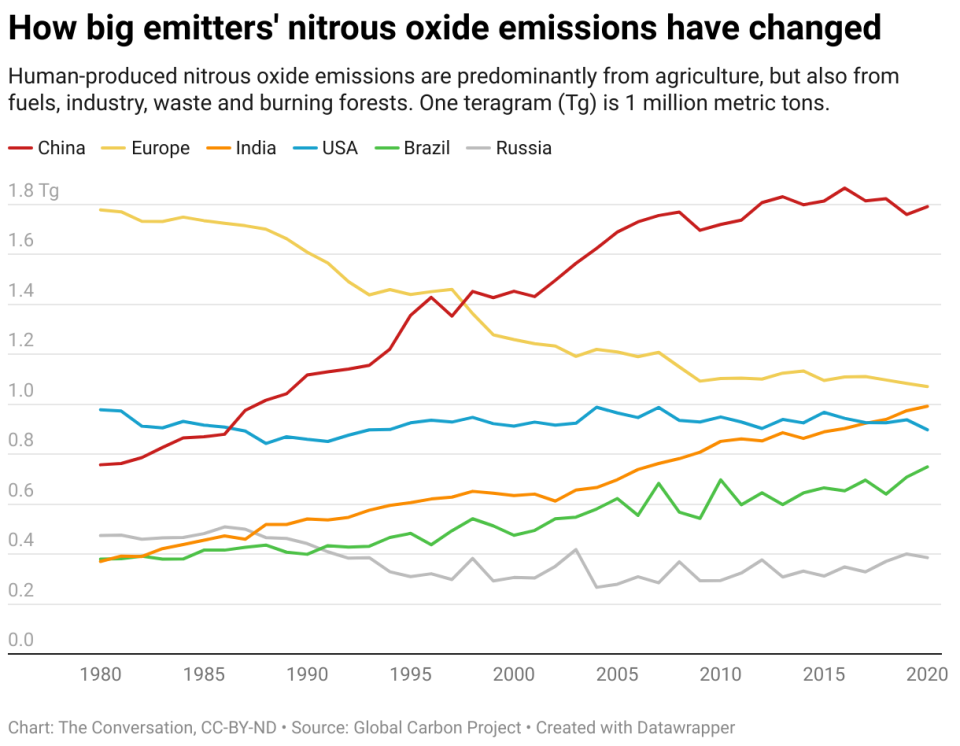

China is the largest producer and user of chemical fertilizers. Its Action Plan for Zero Growth in Fertilizer Use by 2020, released in 2015, helped reduce those N₂O emissions. However, its industrial N₂O emissions are constantly increasing.
In Brazil and Indonesia, cutting down and burning forests to make room for crops and livestock, combined with increasingly intensive farming practices, has worsened nitrogen losses from natural sources and increased greenhouse gas emissions.
Africa has opportunities to increase food production without increasing nitrogen fertilization. However, North African countries have more than tripled their emissions growth over the past two decades, mainly due to significant growth in Africa’s livestock population.
Some regions, however, have been able to cut some of their N₂O emissions with more sustainable practices.
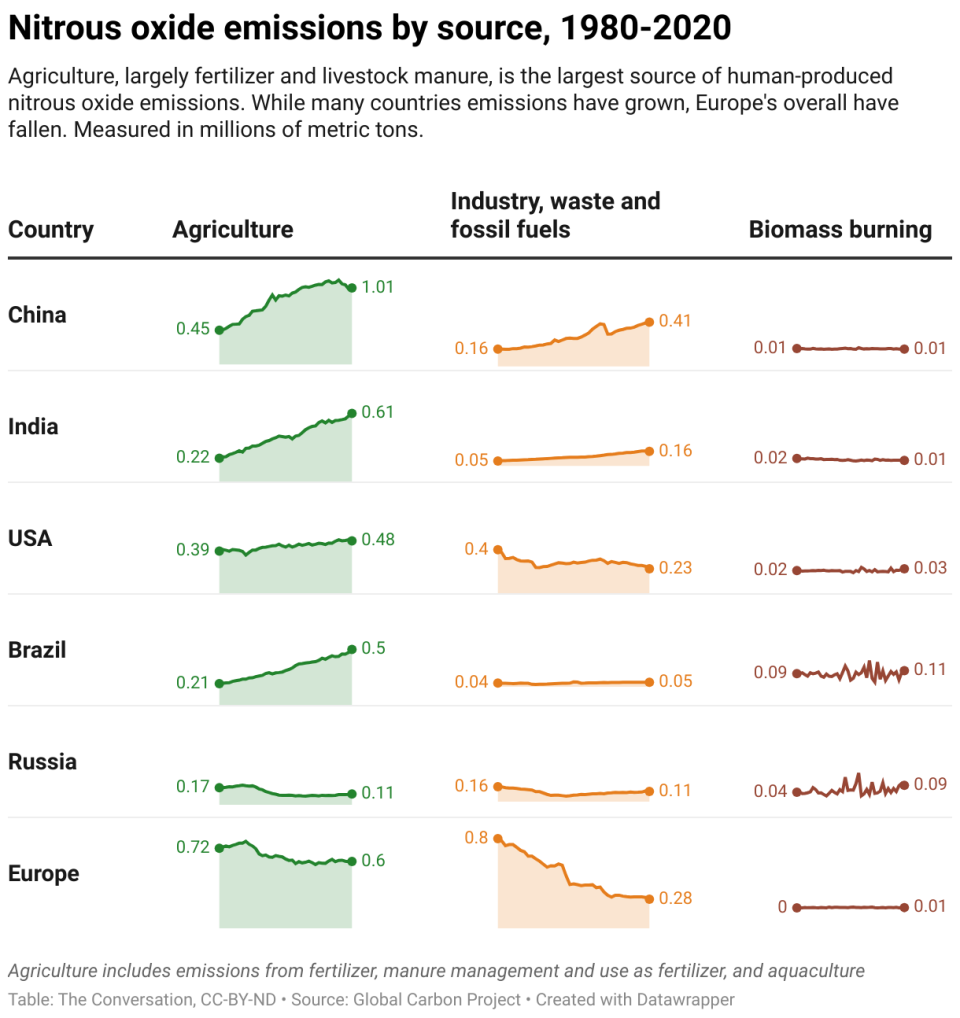

The European Union, Japan and South Korea have succeeded in reducing anthropogenic N₂O emissions over the past 40 years, although they remain major emitters on a global scale; most reductions came from the chemical industry in the 1990s. Their use of nitrogen in agriculture has also become more efficient; however, they still have work to do. Their emissions from the application of direct fertilizer and manure have only slightly decreased and have leveled off recently.
In the United States, agricultural emissions continue to increase, while industrial emissions have declined slightly, leaving overall emissions relatively flat.
How to reduce N₂O emissions
Addressing the challenge of reducing N₂O emissions requires a combination of policy interventions, technological innovation and individual actions. For example:
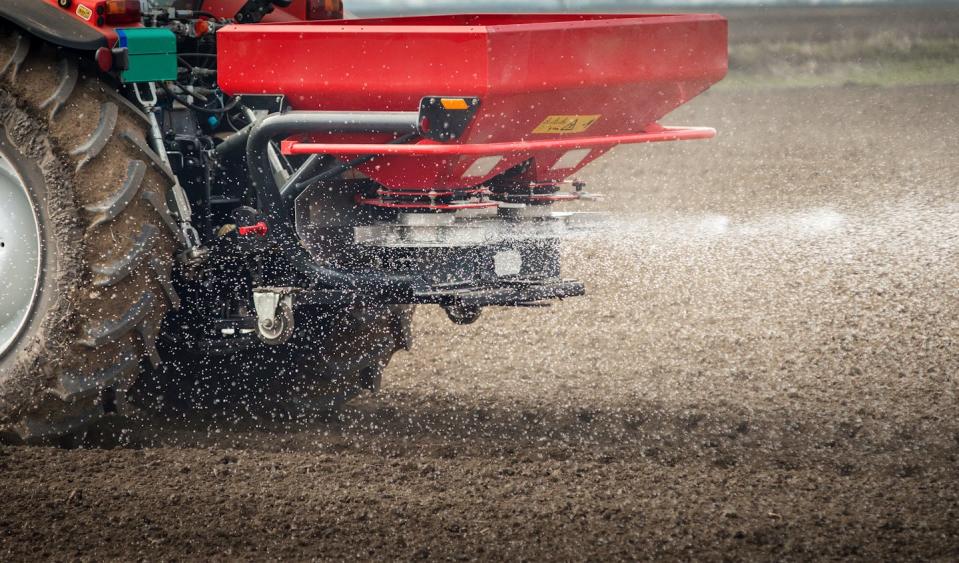

-
Similarly, innovations in livestock management, such as dietary supplements and improved waste management practices, can reduce the amount of N₂O from cattle.
-
Industries, particularly nylon and fertilizer production, can install affordable existing technologies to reduce almost all of their N₂O emissions. That’s an easy win for implementation and climate. Most of the world has already done so, leaving China and the US responsible for most of the remaining industrial N₂O emissions.
-
Consumers can make plant-based foods a larger fraction of their diets. You don’t have to be vegan if you don’t want to, but reducing the frequency and amounts of meat and dairy consumption can be healthy for you and the environment. Eco-friendly practices such as composting food waste and reducing fertilizer use on lawns also help.
Overall, addressing N₂O emissions and tackling climate change requires a holistic approach combining policy, technology and individual actions. As governments, industry and citizens work towards a sustainable future, these strategies can help ensure food security and environmental sustainability for generations to come.
This article is republished from The Conversation, a non-profit, independent news organization that brings you reliable facts and analysis to help you make sense of our complex world. It was written by: Hanqin Tian, Boston College; Eric Davidson, University of Maryland, Baltimore; Pep Canadell, CSIROand Rona Louise Thompson, Norwegian Air Research Institute
Read more:
Hanqin Tian receives funding from the National Science Foundation and the US Department of Agriculture.
Eric Davidson has received funding from NSF, USDA, DOE, and NASA. It is affiliated with the University of Maryland Environmental Science Center and Spark Climate Solutions.
Pep Canadell receives funding from the Australian National Environmental Science Program – Climate Systems Hub.
Rona Louise Thompson receives funding from the European Commission through the Horizon Europe Programme.